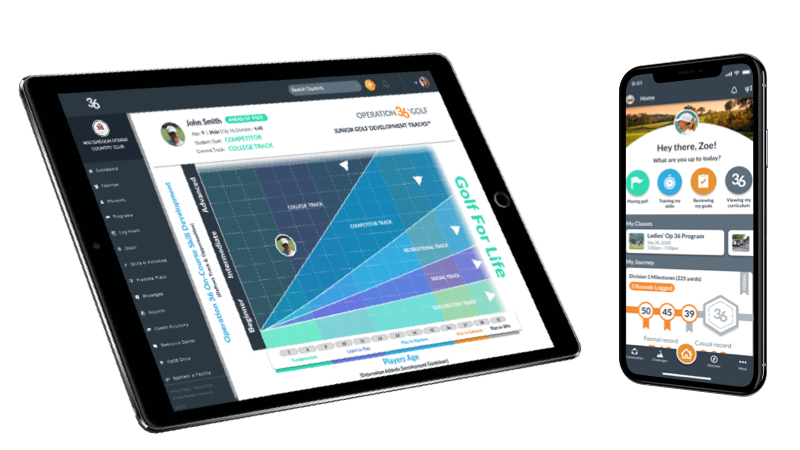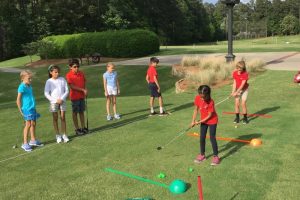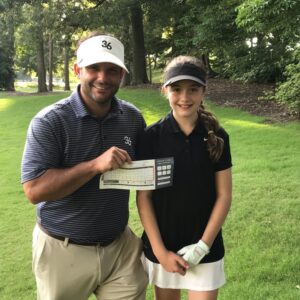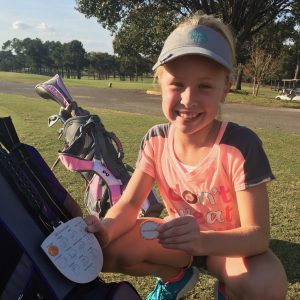
There is a negative force working against beginners golfers from day 1 of their journey. It is rarely talked about and has one job, suck as many newbies out of the sport as possible!
At Operation 36, we call this force “The Black Hole Phase.”
Specifically, we define The Black Hole Phase as the period of time from a beginner's first introduction to the game, to becoming a 26 handicap (can break 50 for 9 holes from a USGA recognized forward tee-box).
Just how big is the problem? According to the CEO of the National Golf Foundation, Joe Beditz, there have been over 12 Million people introduced to the game over the last 5 years, yet our actual golfers have only risen by 200,000. “It’s almost inexplicable,” says Beditz. (Ref: NGF)
This indicates how real The Black Hole Phase is for beginners, yet there are very few suggestions on what Golf Professionals can change to retain all these new golfers.
Here I would like to share some data and insight on why traditional programs are falling short to connect beginners golfers to the game. I’ll also share with you some ideas from the data we have collected at Operation 36 that may help you to rethink the introduction to playing golf.
At Operation 36, we believe that the golf industry massively underestimates the length of time beginners face The Black Hole Phase. We are underestimating how long it takes someone to go from never swinging a club to becoming a skilled golfer who wants to play the game for life.
It is proven that the more skilled a golfer is, the more likely they will identify as a golfer and want to play golf consistently. When you play better, you play more.
Did you know that 93% of male golfers are a 26 Handicap or better? Did you know the Average Female Handicap is a 27.5 Index? (Ref: USGA)

These stats tell us that most golfers that play consistently, grow rounds, and grow our game are actually quite skilled! This is precisely why we set the benchmark for where The Black Hole Phase ends at a 26 Handicap. It just makes sense. If we want people to feel comfortable paying to play a round of golf, for life, we need to get them to a skill level that matches that mindset.
Personally, I can still remember writing down my first 49 on the scorecard for 9 holes from a full tee-box. I felt like a golfer. It kept me motivated, I could get around the course with a good pace of play, and I wasn’t afraid to play with other people. I bet there are a lot of existing golfers who can relate to that experience.
What if I told you that from our data and research it takes an average beginner over 55 - 9 hole rounds to develop the skills necessary to become a skilled golfer who could break 50 from a forward tee-box? That is right, over 55 rounds of golf!
I hate to write it, but it is true! Data doesn’t lie. With over 45,000 participants now being introduced to the game using the Operation 36 Development Model and technology, we can measure a beginner's development in a way the industry has never been able to do so previously.

The model is based on our principles of “Scaling by Skill” - All participants are playing a scaled golf course where they have the opportunity to shoot even par (36) every time they play 9 holes. Once they shoot par (36) from a shorter distance, we lengthen (or unlock more of) the course. It’s a clear modeled progression through 10 standard divisions.
Because Operation 36 embraces playing 9 holes from the first day of a golfer's journey and has standards in place to measure on-course skill development, we can track beginners and support them in a unique and objective way.

We don’t just use data to track development, we use it to gamify and encourage players to make them feel good about where they are in their golf game. We then give them clear goals and tools to guide them so they never feel lost on their golf journey.
If we know it takes 55 rounds of golf to turn a beginner into a skilled golfer at the full tee-box, then why are we shying away from getting beginners on the course playing the game! Here are the top two reasons.
Golf Professionals have been offering clinics, camps, and private lessons for years, and very rarely do they include playing golf. This goes for juniors or adults.
Ryan Dailey and I learned the hard way what happens if participants don’t actually play golf outside your program. We lost 40 of our junior program participants. These participants came to our weekly classes consistently for 3 years, but never played golf! We didn’t think it was our responsibility to provide this. This lesson is what ultimately led to us developing what is Operation 36 today. (Learn more about our story here)

It is tradition to avoid taking beginners on the course and telling them they need to “Get Ready” and keep practicing or taking lessons until they have the skills to play golf. Traditional Program thinking expects the beginners to figure out how to play golf outside of the program. What ends up happening?
We end up overwhelming golfers by teaching them every skill in 5 lessons, and they leave not feeling very good at any of them. Beginners think, “I am not ready for the course and I better keep practicing.” If we are lucky, they actually do persevere and try out playing their first 9 holes, which leads to the next problem.
We can’t keep treating beginners like existing golfers. The reason we shy away from getting beginners on the course is we have never had a standard on-course development model (until Operation 36) to give beginners a motivating and timely way to play 9 holes. Let’s look at an example of a traditional introduction to playing.
If Golf Pros put complete beginners on the most forward USGA recognized tee-box and asked them to play 9 holes and count every stroke, they could easily shoot over a 100 and it would take them 3-4 hours to play. How do I know? This is exactly what we tried after we lost half of our participants in running our own programs.
Now imagine putting this beginner in front of a group of a bunch of skilled golfers. What will happen?
First, there will be a phone call to the pro-shop about slow play. Then a ranger will tell the person to pick up their pace and that they are playing too slow. After taking 15 shots on the first hole, the person already feels defeated and ends up just picking up their ball. Embarrassment sinks in and they might try a few more holes.
When they return to their car and drive away, they say again, “I am not ready to play golf, I better keep practicing." The only problem is, golfers, don’t keep practicing. They end up thinking the mountain is too big to climb, the negative force works against them, they lose purpose, and they quit golf. Another victim to “The Black Hole Phase”!
What if every golf professional was paid a $10,000 bonus every time they could get one of their beginner participants to a 26 handicap? They actually created a golfer that will play golf and drive the industry forward.
If the Golf Pro knew that the student was 55 rounds away from becoming a 26 handicap, what would that coaching environment look like? Would they keep running traditional drop-in clinics and keep telling golfers they aren’t ready to play? Probably not!
If I were going to get a $10,000 bonus for every person I progressed to a 26 handicap I would:
Over 500 facilities are already embracing these types of environments with the Operation 36 Program. Our network takes pride in providing beginners with a complete Developmental Program and doesn’t shy away from giving golfers a clear and motivating plan with measurable results.
So what if every golf professional was paid a $10K bonus every time they could get one of their beginner participants to a 26 handicap? The truth is, Golf Pros who are embracing a developmental program like Operation 36 actually are! They are just being paid upfront monthly by a lot of players to help progress them.
To make a change there needs to be a win-win-win. Beginners need to see the value of a long-term program, Golf Professionals need to see the value to run the program, and finally so does the Golf Facility.
Here is a simple model for the Assistant Golf Professionals making $24,000 salary to think about. Build a group academy environment to help 100 players at $100 a month and you are adding $10,000 a month in revenue, coaching 10-15 hours a week. You can now run the program as many months as your season allows. Pretty simple right?
When Golf Professionals choose a developmental program, they transition to predictable class numbers and consistent revenue. It's better for a Golf Pro (who is already busy enough) and it provides an affordable environment for beginners to enjoy becoming skilled life-long golfers. Last, but not least, the facility actually benefits because they are now getting new customers who will pay for a round of golf and not just sit on the range.




True game growth.
It's easier to keep doing what we have always done. Many golf pros suffer from unpredictable income because they can’t count on sign-ups for clinics and one-on-one lessons. Beginners don't commit to programming because they don't see the long-term plan or know where they are in the process.
To make the switch Golf Professionals need a long-term development model and programming that is clear and proven. It needs to make sense to golfers. You need to have all the tools to progress them.
If you can't retain golfers, it is because they aren't feeling and seeing the value. In our eyes, Play-Centered Developmental Programs are the future. Instead of shying away from telling folks it takes a while to become a skilled golfer, let's be honest with them, then provide them with a clear and motivating plan!
We don't need to spend $1,000,000's on redesigning every golf course or adding a bunch of tee-boxes, we just need to redesign the narrative we give beginners as they start the sport. This starts with better programming and a model that everyone can get behind.
Remember, there were over 12 million beginners introduced to the game over the last 5 years that needed a developmental program. We only retained 200,000.
That's potentially 11,800,000 who left that were excited about golf and would have happily paid $100-$200 a month to participate and have a complete developmental program environment to become a skilled golfer.
How many more golfers are we going to lose to The Black Hole Phase? A lot if we don’t change and start giving beginners a clear long-term plan.
The program locations at Operation 36 won’t stop crafting a better developmental program and getting it in the hands of passionate Golf Professionals who care until the problem is solved.
Are you a Golf Pro interested in learning more about how to structure a developmental program? Take our free course “The 3 Keys to Running a Successful Developmental Program” today - CLICK HERE